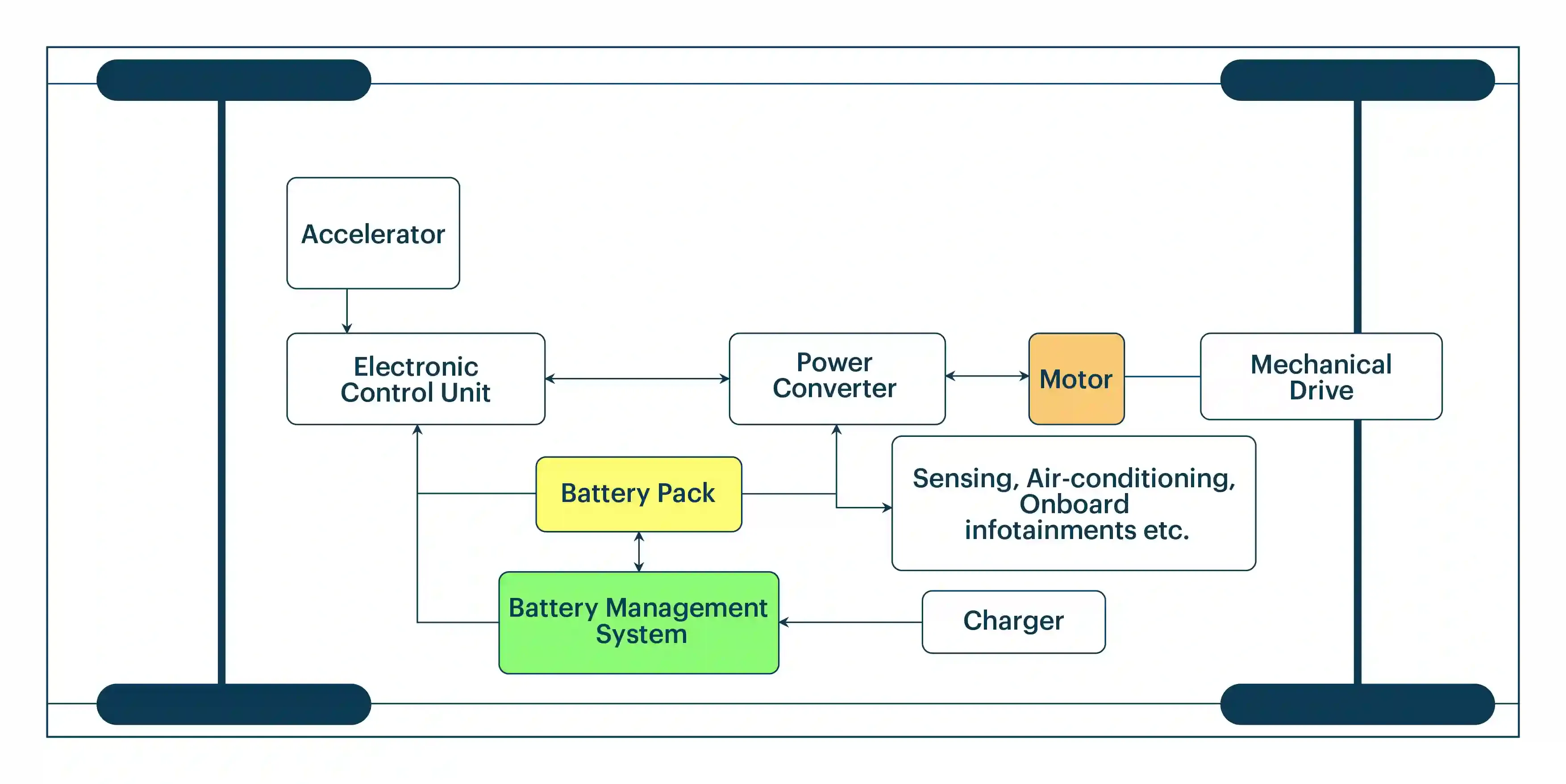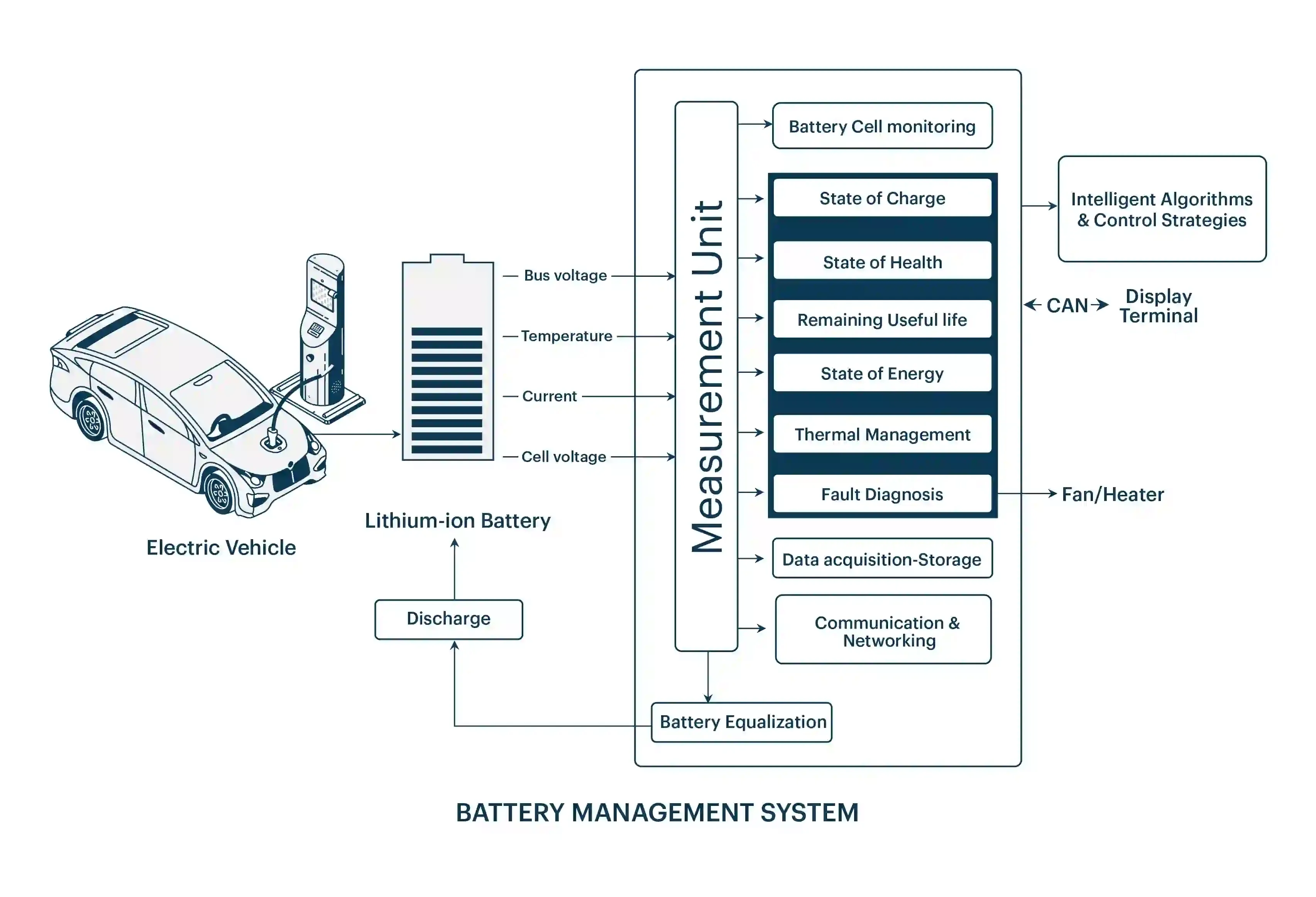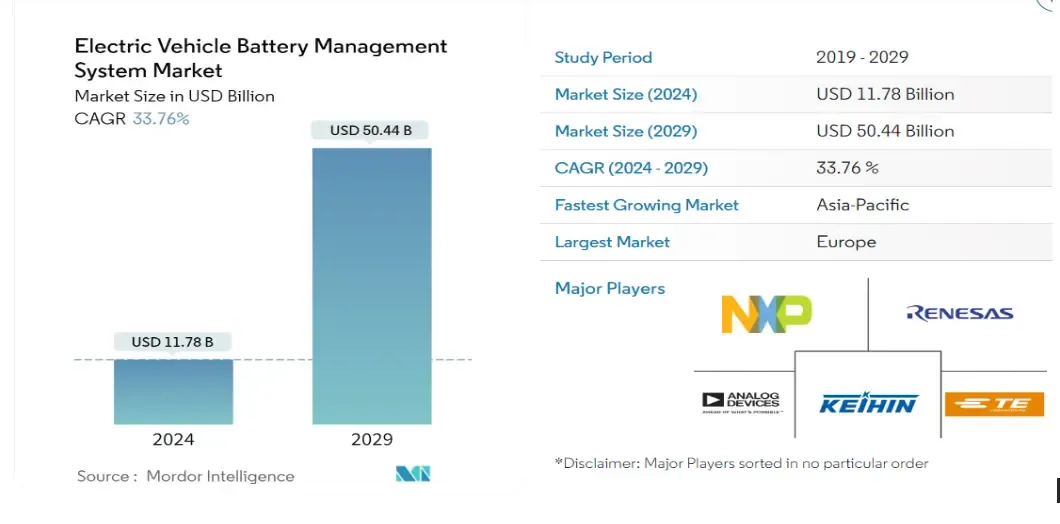The Changing Face of the Electric Vehicle Forefront with Battery Management Systems
Have you noticed how the fight against climate change and the drive for sustainability are sparking a remarkable boom in the global electric vehicle (EV) market?
The battery management system for electric vehicle (BMS) plays a critical role in ensuring the safety, efficiency, and longevity of EV batteries. As electric vehicles rapidly replace traditional gasoline-powered cars due to their zero emissions, understanding the function and importance of the BMS becomes essential for both industry professionals and enthusiasts.
But the world is fast moving! As per latest reports, China hopes to commercialize flying electric vehicles by 2030!
From ICE-driven cars to today's state-of-the-art electric vehicles, we have come a long way in the journey of automotive innovation. Today, flying cars and electric vertical takeoff and landing (eVTOL) vehicles are being tested in our airspace. We can confidently say that the day is not far off when flying cars will transition from a mere dream to tangible reality in the world of transportation.
Even as new inventions emerge, one integral component that consistently plays a critical role across all horizons in EV technology is the battery pack.
In this blog, we will delve into the complexities of Battery Electric Vehicles (BEVs) and the critical role played by Battery Management Systems for electric vehicles. As the automotive industry undergoes a shift towards electrification, it is imperative to understand the technologies that control the performance efficiency of these sustainable transportation solutions.
Battery Electric Vehicles and the Role of Battery Management Systems (BMS)
Battery Electric Vehicles (BEVs) are vehicles with no tailpipe emissions. Unlike conventional internal combustion engine (ICE) vehicles, BEVs are designed to operate solely on the chemical energy stored in their traction battery arrays, eliminating the need for fossil fuels.
The latest report from Fortune Business Insights indicates, the EV market size is projected to grow from $500.48 billion in 2023 to $1,579.10 billion in 2030, with a CAGR of 17.8% in forecast period, 2023-2030.
Electrifying Rides and the Future with Battery Management Systems for Electric Vehicles
BEVs are full electric vehicles powered exclusively by rechargeable battery packs instead of the conventional internal combustion engines (ICEs). By harnessing the power of electric motors and motor controllers, BEVs convert the stored electrical energy into mechanical energy, propelling the vehicle without the need for a gasoline engine or any other auxiliary power source.
Battery electric vehicles offer several advantages beyond their environmental benefits. Their electric drivetrain architecture results in higher energy efficiency compared to ICE vehicles, translating into lower operational costs and reduced dependence on fluctuating fuel prices. Additionally, the inherent simplicity of electric motors and the absence of complex mechanical components lead to lower maintenance requirements and potentially longer vehicle lifespans.
Automotive-grade Cellular IoT Modules
Equip your Vehicles with the power of next-generation IoT Modules
Types of Batteries Used in Electric Vehicles and Their Management by BMS
The following are electric vehicle batteries that have been commonly used in the automotive industry:
Lithium-ion (Li-ion) Batteries
Lithium-ion batteries are the most popular batteries that can be used for an array of applications from mobile phones to all portable electronic devices. Lithium-ion batteries are more efficient than any other types of batteries when considered for electric vehicles.
They are the predominant electric vehicle battery choice for most modern EVs due to their high energy density, long cycle life, and relatively low self-discharge rate. They have a high energy to unit mass ratio, lightweight with low or no self-discharge in idle conditions, making it the ideal choice for all HEVs and EVs.
The most common lithium-ion chemistries used are Lithium Nickel Manganese Cobalt Oxide (NMC), Lithium Iron Phosphate (LFP), and Lithium Nickel Cobalt Aluminum Oxide (NCA). NMC and NCA batteries offer higher energy densities but have slightly shorter lifespans when compared to LFP batteries. On the other hand, LFP batteries are known for their enhanced safety, longer cycle life, and lower production costs.
Lead Acid Batteries
The lead acid battery holds a significant place in the evolution of electric vehicle battery technology. It was the pioneering battery technology used in early electric vehicles. Despite its relatively low energy density and substantial weight, lead acid batteries offered several advantages that made them viable for electric mobility applications of the time. Their low manufacturing costs, robust construction, and decent efficiency levels compensated for their inherent limitations.
However, as technological advancements accelerated, the emergence of lithium-ion battery technology disrupted the landscape and lead acid batteries largely phased out from modern electric vehicle applications.
Today, these former electric vehicle batteries find their utility in low-power applications and backup power systems, where their cost-effectiveness and durability outweigh the need for higher energy densities.
Nickel-Metal Hydride (Ni-MH) Batteries
Ni-MH batteries were widely used in early generations of EVs and hybrid electric vehicles (HEVs). They are modified versions of Nickel Cadmium batteries. They were mainly used in hybrid electric vehicles that used batteries to enhance the performance of internal combustion engines (ICEs).
While they have a lower energy density compared to lithium-ion batteries, Ni-MH batteries are known for their durability, reliability, and tolerance. They are charged with regenerative braking and have a high self-discharge rate. Ni-MH electric vehicle batteries are becoming less prevalent in modern EVs due to these shortcomings and advancements in lithium-ion technology.
Understanding the Battery Management System for Electric Vehicles
Battery Management System (BMS) is a sophisticated electronic system responsible for monitoring, regulating, and optimizing the battery pack's operation. It is essential to have a well-designed and highly capable BMS that can ensure the battery's safety, longevity, and consistent power delivery.

Operation of BMS inside an Electric Vehicle (EV)
Battery Management Systems: The Brains Behind EV Batteries
A Battery Management System (BMS) encompasses a comprehensive set of practices and technologies meticulously designed to optimize the efficiency of battery packs by overseeing various battery parameters.
The Battery Management System (BMS) is like Tony Stark’s Jarvis from Avengers.
As Jarvis monitors the Iron man’s suit systems, here the battery management system constantly monitors and optimizes the battery's performance through certain functions. These functions of the BMS are listed below.
State of Charge (SOC)
The SOC represents the percentage of remaining battery capacity, providing crucial insights into the available energy reserves. Accurate SOC estimation is essential for effective power management and preventing over-discharge scenarios that could permanently damage the battery.
State of Health (SOH)
A diagnostic indicator, the SOH measures a battery's overall health and degradation over its operational lifetime. This metric accounts for factors like cycle aging, temperature effects, and impedance changes, enabling predictive maintenance and timely battery replacements.
Voltage and Current
Continuous monitoring of voltage and current levels is fundamental to ensuring safe battery operation. Monitoring these parameters helps ensure safe operation and prevent overcharging or excessive discharge. BMS algorithms actively regulate these parameters to prevent overcharging, excessive discharge rates, or potential thermal runaway events that could compromise battery integrity and pose safety hazards.
Temperature
Optimizing temperature can significantly impact battery life and safety. Thermal management is a critical aspect of battery performance and longevity, especially where devices may operate in diverse and challenging environmental conditions. By optimizing temperature ranges through active cooling or heating mechanisms, the BMS can significantly extend battery life and mitigate safety risks associated with extreme temperatures.
Monitor your fundamental battery parameters with utmost visibility with
Cavli C-Series Cellular IoT Connectivity Modules
Essential Functions of a Battery Management System (BMS) for Electric Vehicles

Functions of BMS in an Electric Vehicle
State-of-Charge (SOC) Estimation
The battery management system (BMS) in an electric vehicle (EV) is crucial for accurately calculating and reporting the state of charge (SOC) of the battery pack. SOC estimation prevents overcharging or deep discharging, safeguarding the battery's health and longevity. The BMS in EVs monitors essential parameters like voltage, current, and temperature, providing accurate SOC calculations that determine the remaining charge in the battery. This information is vital for planning vehicle range and strategically halting at charging stations, ensuring a smooth and reliable electric driving experience.
Cell Balancing
A battery management system for electric vehicles is responsible for balancing individual cell charge levels, preventing issues from overcharging or undercharging. This function ensures that all cells operate at uniform voltage levels across the battery pack, enhancing EV battery performance and longevity. The BMS employs methods like active and passive balancing to manage individual cell behavior, providing stable and balanced battery performance, which is essential for the smooth operation of an electric vehicle.
Battery Safety
Safety is a core function of the battery management system for electric vehicles, as it protects against overvoltage and undervoltage by monitoring and regulating safe voltage levels. It also limits excessive current flow, preventing potential damage to both the battery and other EV components. Through continuous monitoring, the BMS detects and mitigates short circuits and other security hazards, ensuring the integrity and safety of the entire EV battery system.
Thermal Management
Thermal management is another critical role of the battery management system in EVs. By constantly monitoring battery pack temperatures, the BMS prevents overheating and helps maintain an optimal operating temperature range. It actively manages cooling and heating systems within the battery pack, protecting battery integrity and ensuring safety by avoiding thermal runaway – a critical factor for enhancing battery life and overall performance in electric vehicles.
Fault Diagnosis
The battery management system for electric vehicles is designed to detect and diagnose faults, providing users with alerts about potential issues. This function is crucial for maintaining safety, as the BMS can isolate or mitigate risks to ensure reliable vehicle operation. Through continuous diagnostic checks, the BMS identifies faulty cells and provides information to guide maintenance and replacement, supporting proactive battery care and maximizing EV battery lifespan.
Cell Monitoring
Real-time monitoring is a key aspect of the battery management system in electric vehicles. The BMS gathers data on essential parameters like cell voltage, temperature, and current to continuously assess battery health. It evaluates the State of Health (SOH) and State of Power (SOP), which are indicators of the overall battery pack's condition. This monitoring allows for preventive maintenance, ensuring a healthy battery that performs reliably and consistently over time.
Types of Battery Management Systems (BMS) for Electric Vehicles: Centralized, Distributed, and Modular

Common types of BMS in an electric vehicle
Image source: tritekbattery.com
Centralized BMS
In a centralized battery management system architecture, a single control unit oversees the management of each individual cell. This central BMS within the battery pack is intricately linked to all other battery packs, forming a cohesive network. This system presents challenges in maintenance and troubleshooting due to its centralized nature. Moreover, there's an elevated risk factor, as if the central BMS encounters a malfunction, the entire system becomes vulnerable.
Distributed BMS
A distributed battery management system architecture employs multiple control units that manage the battery cells. All the electronic components are housed on a control board placed on the cells or modules. It eliminates extensive wiring and cable clutter, facilitating easier troubleshooting and maintenance. Despite the higher upfront cost investment, the distributed BMS design provides enhanced reliability, flexibility, and tailored EV battery management systems.
Modular BMS
A modular battery management system architecture groups identical battery cells, each in charge of a portion of the battery pack, and provides them a control unit. This control unit then contacts the master control unit to carry out the functionalities. This modular BMS structure employs an equilibrium between both the centralized BMS and distributed BMS, offering a balance in system structure, complexity, maintenance, and performance.
What Lies Ahead: Forecasted Market Size of EV BMS in 2024-29
The EV Battery Management System Market size is estimated to grow from USD 11.78 billion in 2024, and is expected to reach USD 50.44 billion by 2029, with a CAGR of 33.76% during the forecast period 2024-2029.
Emerging Trends in Battery Management Systems for Electric Vehicles
Cloud-based BMS
Cloud-based Battery Management Systems are gaining popularity, enabling remote monitoring, data storage, and analysis of battery performance. By leveraging cloud computing and IoT technologies, BMS data can be accessed and analyzed from anywhere, facilitating predictive maintenance, fleet management, and performance optimization across multiple battery systems.
Wireless BMS
Traditional Battery Management Systems rely on wired connections between the battery modules and the central control unit. Wireless Battery Management Systems aim to eliminate these physical connections, enabling more flexible and cost-effective BMS. Wireless communication protocols like Bluetooth, ZigBee, or proprietary wireless technologies are used in Wireless BMS to transmit data signals between the battery modules and the BMS controller. This approach reduces wiring complexity and cable clutter, facilitating easier maintenance and scalability at a much lower cost.
Machine Learning (ML) and Artificial Intelligence (AI)
The integration of ML and AI algorithms into BMS systems is gaining traction. These advanced techniques can improve various aspects of battery management, such as:
- SOC and SOH estimation: ML models can more accurately estimate the SOC and SOH by learning from historical data and adapting to battery aging and usage patterns.
- Predictive maintenance: AI algorithms can analyze battery data to predict potential failures or performance degradation, enabling proactive maintenance and reducing potential downtime.
- Thermal management optimization: ML models can optimize the thermal management strategies based on usage patterns, environmental conditions, and battery characteristics, improving efficiency and extending battery life.
Closing Notes
The success of EVs heavily relies on the efficient management and optimization of their battery systems, which is where the EV Battery Management System (BMS) plays a pivotal role. The BMS is the unsung hero of EVs, responsible for ensuring the safe, reliable, and efficient operation of the battery pack.
As we look towards the future, the BMS is evolving to meet the growing demands of the EV industry. Emerging trends like wireless communication, machine learning integration, predictive analysis, and cloud-based monitoring are pushing the boundaries of what a BMS can achieve. These advancements not only enhance the performance and longevity of battery packs but also pave the way for more advanced and streamlined vehicle systems.



